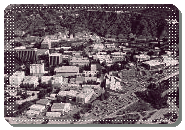
The Jet Propulsion Laboratory (JPL) is one of the main centers of NASA, managing most of the planetary missions for the agency. The JPL is a division of the California Institute of Technology (Caltech). The JPL began as a group of students of the California Institute of Technology (Caltech), in the 1930s, led by professor Theodore von Kármán, head of Caltech's Guggenheim Aeronautical Laboratory and an adviser to the U.S. Army Air Corps, working about rocket propulsion. In a dry canyon wash in the foothills of the San Gabriel Mountains five grad students studying at Caltech and two amateur rocket enthusiasts helped jump-start the Space Age. By Halloween 1936 they tried lighting a liquid rocket engine. It took them four attempts to get a rocket to fire for three seconds . After 1936, the group turned into an army-funded group working on strap-on rockets to help overloaded Army airplanes to take off from short runways. They were working on a land in the Arroyo Seco, in Pasadena, which had been acquired by the Army. It's there that the group was asked for a technical analysis of the V-2 program which had been unveiled by the Allies intelligence. It's then, when von Kármán proposed as an answer to develop a proper guided missiles program, that the Caltech team referred to themselves as "the Jet Propulsion Laboratory". The Jet Propulsion Laboratory was officially named in 1944 and sponsored by the U.S. Army to develop rocket technology and the Corporal and Sergeant missile systems. From 100 rocket engineers, the team eventually reached 300 by WWII's end, developing a missile program and mastering all the aspects of it, like the propulsion systems, the technologies of communications and control, design and test, and performance analysis. It's the JPL which, during 3 months in 1957-1958, led the effort to Explorer 1, the first U.S. manmade satellite, which launched on January 31st, 1958 as a response to the successfull Russian Sputnik
 | a view of the JPL campus, Pasadena, Calif.. NASA/JPL |
When NASA was created by October 1958, JPL was transferred from the Army to the new agency as its focus transitioned from the rockets themselves to science payloads they would carry. The name 'Jet Propulsion Laboratory' however was retained. JPL then turned the origin of a long series of 'first ever' accomplishments in space journey during the first 5 decades of space history. The JPL is NASA only ' 'FFRDC' ('Federally Funded Research and Development Center') as it works along NASA 9 field centers. As those centers are staffed by government civil servants, JPL is managed for NASA by the prestigious Caltech under a contractual arrangement begun in 1958 and renewed every five years as JPLers are Caltech employees. It's a good example of a place where the government obligations are meeting the academic spirit. From the 1970s until the early 1990s, NASA focused JPL's expertise on large, complex, one-of-a-kind space missions, producing the Voyagers to the outer planets, the Vikings to Mars, the Galileo mission to the Jupiter system, and Cassini-Huygens to the Saturn system. Half a century later, the JPL is always located near the site where von Kármán and his team had worked. The JPL now covers some 177 acres in Pasadena, Calif. Earth science, Earth radar imaging, or astronomy and physics (with missions like the Spitzer Space Telescope) are other centers of interest for the JPL. JPL, too, is managing NASA's Deep Space Network, this set of antennas, which allows to track the various planetary missions and to communicate with them
In 2005, the JPL, 4800 Oak Grove Drive, Pasadena, Calif., had a workforce of about 5,425 employees and on-site contractors, and an annual budget of approximately $1.6 billion. At the head of the JPL, a director is found. Dr. Charles Elachi is the current director since 2001. His predecessors at the head of the Laboratory were Dr. Theodore von Kármán (1944 and forerunner organization), Dr. Frank Malina (1944-1946), Dr. Louis Dunn (1946-54), Dr. William H. Pickering (1954-1976), Dr. Bruce Murray (1976-1982), Dr. Lew Allen Jr. (1982-1990), and Dr. Edward C. Stone (1991-2001). The lab has an open house once a year during two days in May
About the Caltech
The California Institute of Technology (Caltech) has been born in 1891 like a school of arts and craft in Pasadena, Calif., at the initiative of Amos G. Throop, a local businessman and politician. It's George E. Hale, the first director of the Mount Wilson Observatory who, about the time of World War I, developed the institution into a one dedicated to research and education in engineering and the natural sciences, at a time when scientific research was in its infancy in the USA. The physicist Robert A. Millikan, one of the Caltech leaders was awarded the Nobel Price for physics as soon as 1923. Boosted by the growth of Southern Californy in the the 1920s, the Caltech kept growing, attracting most distinguished scientists or beginning the construction of the Palomar Observatory. After WWII, the Institute harboured the greatest particle physicists of the time, Murray Gell-Mann and Richard Feynman, who were central to the establisment of the Standard Model of the particle physics. The Caltech, today, with 2,100 students and 915 faculty members, is still a private institution, governed by a board of trustees